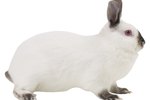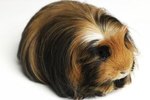
Guinea pigs are sensitive creatures that need to be monitored carefully. Despite the burrito shape of their bodies, guinea pigs have rather small legs supporting a considerable amount of weight. That’s why it’s vital that your cavy maintains a healthy weight.
Monitoring Weight
At first glance it can be very challenging to identify an overweight or underweight guinea pig. Unlike cats or dogs, their rectangular shape and thick, sometimes fluffy fur can be misleading if you’re attempting to evaluate their weight by sight alone.
While there isn’t a precise weight that is ideal for every guinea pig, most cavy experts will tell you that you should be able to feel your pig’s spine as you run your hand down her back. You should also be able to feel the outline of her ribs under your fingertips.
If you’re unable to feel her spine or ribs, your guinea pig is likely overweight. Conversely, if her spine and ribs are quite pronounced she is probably underweight. Either way, the overall health of your cavy is at risk and needs to be addressed by a veterinarian.
Exercise and Activity
A common misconception is that because of their size, guinea pigs do not need exercise and can be kept in small cages. This could not be further from the truth -- guinea pigs need plenty of room to move around, and benefit from daily exercise and activity. Don’t worry, you don’t need to take your cavy for a walk -- simply providing a large, safe space for them to explore a few hours a day is adequate. A large cage that provides your cavy with plenty of space to walk, scuttle and leap also ensures ample opportunity for exercise.
Balanced Diet
The key to a happy, healthy guinea pig is a balanced diet. Your guinea pig's diet should consist of three things: fresh hay, specially-formulated pellets and fresh vegetables.
Cavies should have constant, unlimited access to fresh timothy hay or orchard grass. Additionally, they should be fed about 1/8 cup of high quality, dye-free pellets each day. Because they’re also eating copious amounts of hay, it’s important to limit your cavy’s daily pellet consumption.
Your guinea pig’s daily food provisions should also include about 1 cup of vegetables and fruit each day -- preferably leafy greens like romaine lettuce, parsley and spinach. Bear in mind most fruit is high in sugar and should therefore be limited to small amounts every few days.
Weigh Your Cavy
Guinea pigs are small, sensitive creatures and their health can deteriorate quickly. An obese cavy will likely develop bumblefoot, heart disease or diabetes, whereas an underweight guinea pig is susceptible to muscle atrophy.
One easy way of monitoring your cavy’s health is to weigh her consistently. Because weight loss or gain of more than a gram is significant in guinea pigs, knowing how much your cavy weighs will help you identify any fluctuations that need to be addressed by a veterinarian.
Weigh your cavy weekly using a scale that can weigh objects of at least 5 pounds. Be sure to provide a safe, stable surface or container for your cavy and never leave her unsupervised, as she will likely jump off.
References
Photo Credits
-
Michael Blann/Photodisc/Getty Images
Writer Bio
Julianne Kroon spends her days caring for animals as the owner an in-home pet sitting business and a dedicated humane society volunteer. She also serves as a national news editor for Internet Broadcasting and previously served as a reporter at a news radio station in Minnesota. Her work has been broadcast on KTOE Information Radio, KMSU Public Radio and featured in the "Mankato Free Press."



